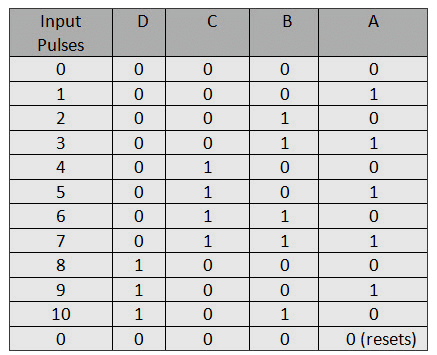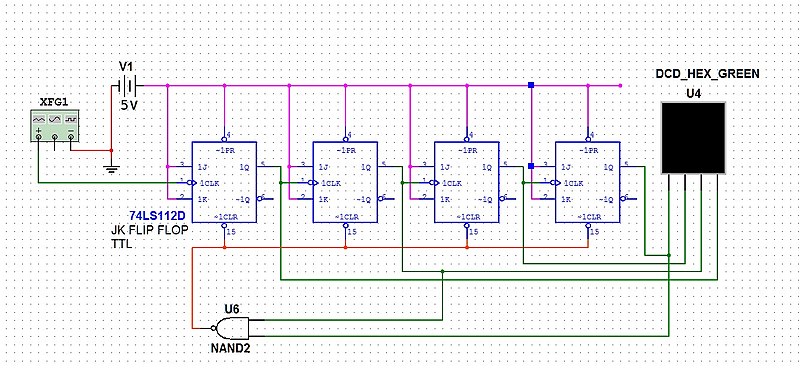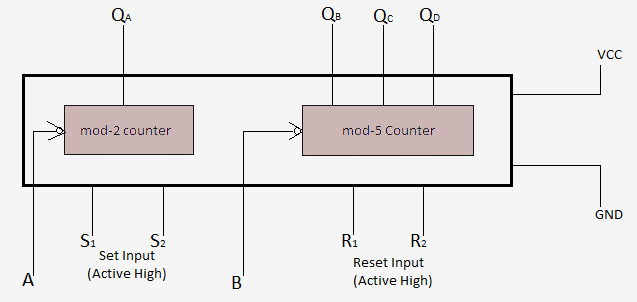Decade counter is very common in today’s electronics. The most commonly available IC CD7490 contains multiple flip flops to convert BCD to decimal and is incorporated as part of larger integrated circuits.
A BCD counter counts in a sequence of ten and then returns back to zero after the count of nine.
Note: Decade counter is also known as BCD Counter.
Decade Counter Truth Table

Note that this is just one example of a truth table for a decade counter. The specific truth table for a given counter will depend on the design of the counter and the specific requirements of the application.
Decade Counter Circuit Diagram

Basically, counters can be implemented quite easily using register-type circuits. Besides the decade counter, there are various other counters that are also used regularly. Let’s take a look.
IC7490 Decade Counter

Counters in Digital Electronics
1. Asynchronous Counter
An asynchronous counter is a simple D-Flip flop, with the output fed back as input. The output changes state for each clock input. This creates a circuit that can store one bit of information. This counter will increment once for every clock cycle and takes two clock cycles for a transition from 0 to 1 and a transition from 1 to 0 creating a new clock with a 50% duty cycle.
2. Synchronous Counter
The clock inputs of all the flip-flops are connected together and are triggered by the input pulses. Thus, all the flip-flops change state simultaneously. An advantage of synchronous counters is that there is no cumulative time delay because all flip-flops are triggered in parallel.
3. Ring Counter
A ring counter is a shift register with the output of one flip flop connected to the input of the next in a ring. Typically, a pattern consisting of a single bit is circulated so the state repeats every n-clock cycle if n flip-flops are used. It is initiated such that only one of its flip-flops is the state one while others are in their zero states
4. Johnson Counter
A Johnson counter is a kind of modified ring counter, where the output of the last stage is inverted before being fed back into the first flop. The register cycles through a sequence of bit patterns, whose length is equal to twice the length of the shift register, continuing indefinitely. It is very commonly found in digital-to-analog converters.
5. Decade Counter
The basic BCD (Decade) counter is an electronic circuit with a 4-bit binary output and an input signal (called a clock). With each clock pulse the outputs advance to the next higher value, resetting to 0000 when the output is 1001 and a subsequent clock pulse is received. Decade counters are used in clock circuits, frequency dividers, state machines, and sequencers, just to name a few applications.
Decade Counter FAQs
Here are some common questions and answers about decade counters:
Q. What is a decade counter used for?
Decade counters are used in a variety of applications where a large number of counts are needed, but space or power constraints prevent the use of a larger counter. Some common applications for these counters include frequency division, pulse generation, and digital display systems.
Q. How does a decade counter work?
A decade counter typically consists of a series of flip-flops, which are used to store the current count. The counter increments or decrements the count in response to a clock signal, and the output of the counter can be observed using a set of LED displays or other types of digital displays.
Q. Can a decade counter count down as well as up?
Yes, It can be designed to count up or down, depending on the specific requirements of the application. A counter that counts down will typically have a different truth table than a counter that counts up.
Q. How do I reset a decade counter?
Most BCD counters have a reset input that can be used to reset the count to zero. The reset input is typically active low, which means that it must be held at a low logic level in order to reset the counter.
Q. Can a decade counter be cascaded?
Yes, it is possible to cascade multiple decade counters together in order to count to even larger values. When counters are cascaded, the output of one counter becomes the input of the next counter in the chain, allowing the counters to work together to count to higher values.
Q. What is the maximum count value for a decade counter?
The maximum count value for a decade counter is determined by the number of output bits the counter has. For example, a counter with three output bits (like the one in the earlier example) can count up to a maximum of 2^3 = 8, before it cycles back to zero.
Q. Can a decade counter be used as a frequency divider?
Yes, a decade counter can be used as a frequency divider by using one of the output bits as a clock signal for a subsequent stage. For example, if a decade counter is clocked at a frequency of 10 Hz, and the Q1 output is used as the clock for a subsequent stage, that stage will be clocked at a frequency of 1 Hz (once per decade).
Q. How do I choose the right decade counter for my application?
When selecting a decade counter for your application, you should consider the following factors:
- Number of output bits: The number of output bits will determine the maximum count value and the resolution of the counter.
- Count direction: Decide whether you need a counter that counts up or down.
- Clock frequency: Consider the clock frequency and pulse width requirements of your application.
- Power consumption: Make sure the counter has a power consumption level that is appropriate for your application.
- Size and weight: Consider the size and weight constraints of your application.
Q. Are decade counters available in different packages?
Yes, decade counters are available in a variety of different packages, including through-hole, surface mount, and custom packages. The package you choose will depend on the specific requirements of your application, such as the available space and the type of circuit board you are using.
Q. Are there any alternatives to using a BCD counter?
There are several alternatives to using a BCD counter, depending on the specific requirements of your application. Some possible alternatives include using a binary counter, a ripple counter, or a programmable counter.
Advantages:
- Large count range: Decade counters can count up to a maximum value of 2^n, where n is the number of output bits. This allows them to count very large values, making them useful in applications where a high degree of resolution is required.
- Simple design: BCD counters are relatively simple circuits that can be implemented using a few flip-flops and some logic gates. This makes them easy to design and debug.
- Wide availability: Decade counters are widely available and can be purchased from a variety of manufacturers.
Disadvantages:
- Limited resolution: Because decade counters count in decades (multiples of 10), they may not provide sufficient resolution for some applications. For example, a counter with three output bits can only count up to a maximum of 2^3 = 8, before it cycles back to zero.
- Limited speed: BCD counters are typically slower than other types of counters, such as binary counters, because they use more stages. This may make them unsuitable for high-speed applications.
- Power consumption: BCD counters can consume more power than other types of counters, which may be a disadvantage in applications where power consumption is a concern.
BCD Counter/Divider with Ten Decoded Outputs Datasheet: click here
For a more detailed lesson on counters, have a look at the presentation below;
This article was first published on 26 August 2017 and was updated on November 2023











